When accepting garments for cleaning, there are some basic things we must look for during every transaction, such as:
- Spots and stains
- Missing buttons
- Damaged trims
- Color loss
- Care instructions
There are also some more challenging items that need to be checked carefully before accepting them for cleaning. You will need to know what your plant’s policies are, what types of items require release forms, and the items your plant does not accept for cleaning.
CARE LABELS
No Care Label
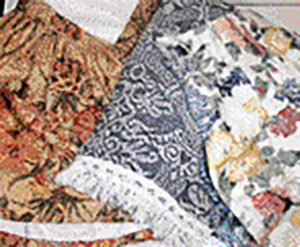
Some items that come into a cleaning plant won’t have care instructions attached. The Federal Trade Commission’s Care Label Rule does not require care instructions on all items. Another possibility is the customer may have removed the care label.
The Care Label Rule requires the manufacturer or importer of textile garments to provide instructions for a single care procedure. Other apparel items such as leather, fur, shoes, gloves, hats, handkerchiefs, belts, suspenders, neckties, and non-woven garments made for one-time use are not required to have care instructions. Household items such as drapes, comforters, and bedspreads also are not covered by the rule.
The following items do not need care instructions:
- Products sold to institutional buyers for commercial use—for example, uniforms sold to employers for employee use in job-related activities, but not purchased by the employees.
- Garments custom-made by a tailor or seamstress from materials provided by the customer.
- Products granted exemptions under the original Care Label Rule because they are completely washable and retail for $3 or less.
When accepting garments for cleaning it is important to learn as much about them as possible, such as the age of the item, what’s been done in prior care, and whether there are any coordinating items, so the cleaner can better determine if they can be safely cleaned without causing damage.
Spot Clean Only
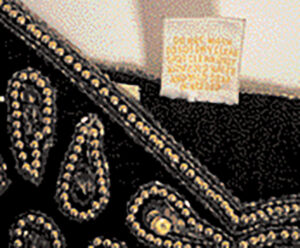
According to the Care Label Rule, if a garment cannot be cleaned by any available cleaning method without being harmed, the label must state this. For example, if a product would be harmed by both washing and dry cleaning, the label might say, “Do not wash – do not dry clean – spot clean only.”
It is the practice in some plants that these items be tagged for the dry cleaner to determine what can be done. Others accept them only if the customer signs a release or permission-to-process form. Still others do not accept items with this label. Check your plant’s policy before accepting these items. If the item is accepted, assure the customer that the garment will be checked carefully and if the dry cleaner feels there will be any problem caring for it, the customer will be contacted to determine how to proceed.
HOUSEHOLD GOODS
Drapes
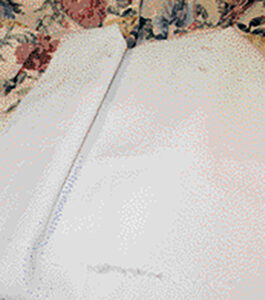
Drapes can be made of many different fibers and have linings or coated backings. They should be inspected carefully for the following:
- Look for care instructions and fiber content information. If they are not attached to the drapes, ask if the customer has that information.
- Check for light fading, water spots, weak or thin areas, and stains. Explain that water spots are very difficult to remove and that every effort will be done to improve the appearance of the drapes.
- Measure the drapes.
- Examine drapes with coated backings for peeling and to evaluate the condition of the coating. If it has started to crack, peel, or has been altered in any way, it may be best to not accept them.
Sofa Cushion Covers
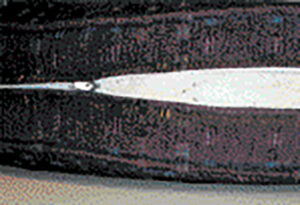
Cushion covers on upholstered furniture are not designed to be cleaned by immersion in solvent or water. These items have different cleaning instructions designated by the fabric manufacturer. The cleaning codes for these items are S, W, S/W, or X. These codes indicate the fabric has been designed for surface cleaning only or cleaning by a professional furniture cleaning service.
All the codes for cleaning upholstered items come with the following caution note: “Never remove cushion covers for separate dry cleaning or washing. Any tumble cleaning method can destroy the back, shrink, or otherwise damage upholstery fabric.” Check your plant’s policy regarding acceptance of these items. Consult IFI’s upholstery bulletin, TOI No. 611, for further information on upholstery cleaning codes.
Feather Beds and Down-Filled Comforters
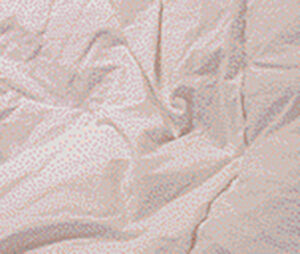
Check your plant’s policies about accepting down comforters or feather beds. These items need to be carefully inspected before accepting for cleaning. Be sure to check for the following:
- Adequate quilting to prevent the down from shifting during cleaning.
- Care instructions (if any).
- Stains.
- Rips or tears that would need to be repaired before cleaning.
FABRICS
Silk
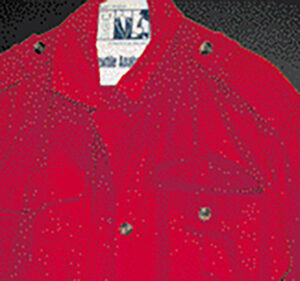
be seen under the collar and pocket flaps.
Silk fabrics can be damaged by light, perspiration, products containing alcohol, and rubbing the fabric while wet. Carefully inspect for any existing problems and note them on the ticket.
- Check under collars and shoulders for light fading.
- Warn the customer that stains that have been treated by rubbing with water may appear lighter or exhibit color loss after cleaning.
- Look for stains from hairspray, since there may be color loss in those areas after cleaning.
Fabrics from Acetate Fibers
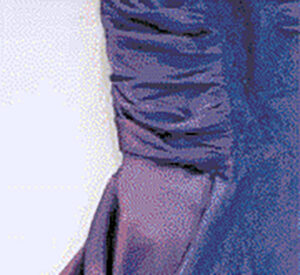
be seen under the collar and pocket flaps.
Acetate fabrics are prone to fume fading from nitrous oxides in the atmosphere. The color change usually occurs on green, black, blue , or purple acetates that turn a reddish hue and affects both sides of the fabric.
- Check for color changes.
- Warn customers that cleaning may make the change more evident.
- Check underarms for perspiration stains.
Velvet
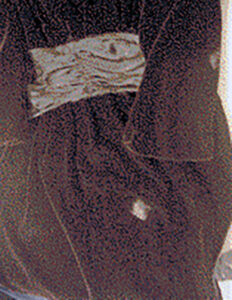
A pile weave velvet made from rayon, acetate, or silk fibers can be damaged by anything that contains water.
- Check for areas where the fibers have been flattened, such as underarms, the waistline, and the back of skirts.
- Explain that cleaning may improve the appearance of the fabric, but the garment may still have some distortion.
- Note existing damage on the ticket.
- Check for food and beverage spills that may have caused the fibers to flatten.
TRIMS
Glitter
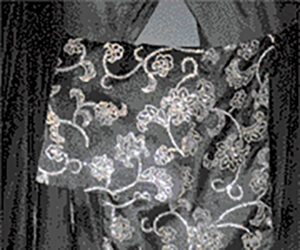
Garments with glued-on glitter need to be meticulously inspected:
- Check carefully for care instructions.
- If the glitter comes off on your hands, cleaning will remove more of it.
Clothing with glued-on glitter may be something that cannot be cleaned by any method. Check the plant’s policy regarding accepting these items.
Glued-on Disc/Paillettes
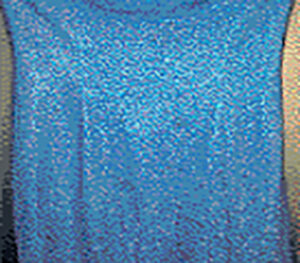
Glued-on flat ornamental discs applied to fabric as decoration can be made of plastic, metal, or shell. They are usually circular or rectangular.
- Check for care instructions.
- Check carefully for any missing discs.
- Warn the customer that the cleaner will have to evaluate the item to determine if it is safe to clean. If there are any problems cleaning the item, the cleaner will contact the customer to discuss how to proceed.
STAINS
Large Stains
Large stains on garments can present problems in cleaning. How successful stain removal is will depend on the characteristics of the fabric, such as colorfastness and garment construction, and the type of stain, and its duration on the garment.
- Ask if the customer knows what the stain is.
- Determine if he/she has tried anything to remove it and, if so, with what. Warn the customer that any attempt at stain removal may have damaged the item.
- Do not promise same-day service for garments with large stains, as they will take longer to process.
- Promise only to do the best job possible to protect the fabric based on fiber content, fabric construction, and the type of dyes used. Don’t make the customer any guarantees beyond that.
Perspiration Stains
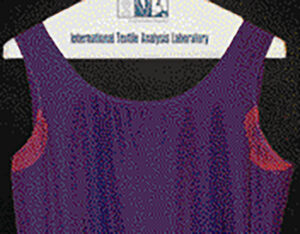
Perspiration can be harmful to fabrics in many ways. It can cause some dyes to bleed, form difficult-to-remove salt rings, and weaken some fibers. Improper use of some deodorants and antiperspirants can result in chemical damage, buildup of the product, discoloration, or a combination of the above. Look for the following on garments:
- Color change, especially in underarm areas.
- Rings, yellowing, or stiffness in underarms.
- Small holes or thin areas in the perspiration rings, which can result in larger holes after cleaning.
Warn the customer that a color change due to perspiration, deodorants, and antiperspirants may not be corrected.
CUSTOMER RELEASE FORM
There are many generic release forms available. Whenever a customer is asked to sign a release, make sure he or she clearly understands the potential problems. Also ensure the customer that care will be taken to prevent damage from occurring. If the cleaner foresees severe problems or damage, the procedure will not be done without the customer’s permission. Supplying customers with technical bulletins that address the type of potential damage or problem can be of help in making them understand your plant’s concerns. The following is a sample customer release form, courtesy of the North East Fabricare Association.
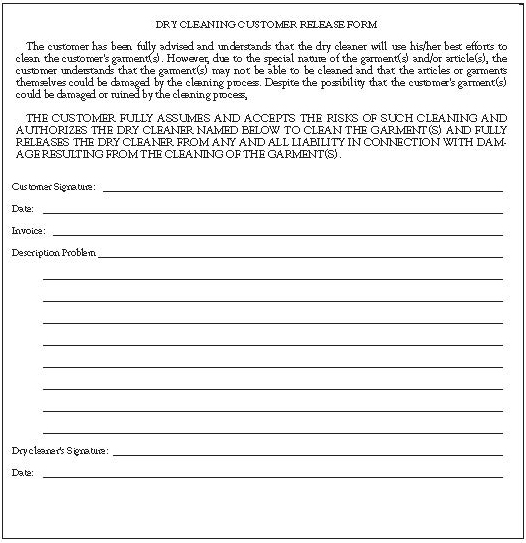
This article is from IFI’s bulletin CS07

